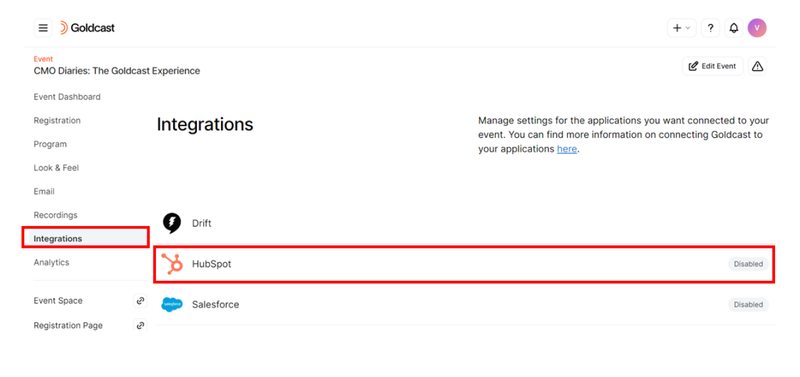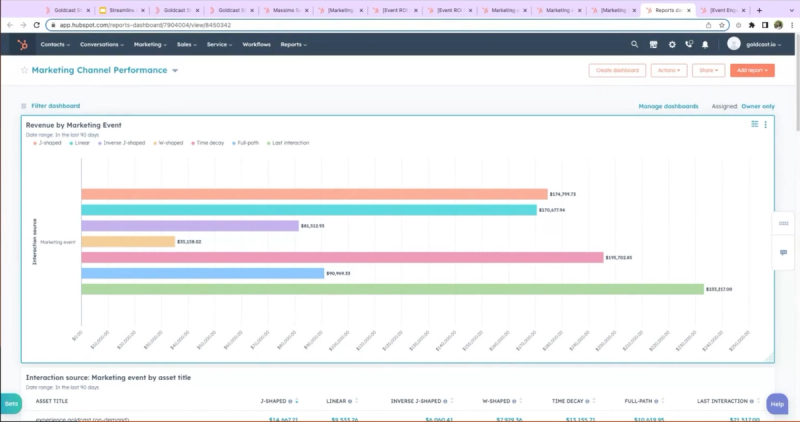HubSpot Meets Goldcast: 5 Simple Steps to Propel Your Event ROI
It’s time to turn your event data into new meetings and revenue. Crush your event goals and save time on manual reporting with Goldcast's deep native HubSpot integration.
You know HubSpot. You love HubSpot. And if you’re like most marketers, you probably eat/sleep/breathe HubSpot.
Whether it’s creating customized content for the perfect nurture strategies, streamlined workflow automations, or simple, visual reporting—most marketers can’t imagine life without HubSpot.
But when it comes to getting insights straight from your event platform and making them instantly actionable inside HubSpot, the process isn’t always as seamless as it should be. Having the right digital events platform can change all of this!
In this step-by-step guide, we’ll show you how to easily send data straight from Goldcast into HubSpot to close the gaps in your marketing operations and see greater results with each campaign.

Why use HubSpot + Goldcast?
Unlock the true potential of your events with Goldcast's deep native HubSpot integration.
Say goodbye to manual reporting and hello to a streamlined process that will help you crush your event goals while saving valuable time.
With Goldcast's HubSpot integration, you can seamlessly nurture attendees, capture key account activity, and launch targeted outreach campaigns, all within HubSpot.
Here are just a few of the undeniable perks of using HubSpot and Goldcast together:
- Use your UTMs to seamlessly track your mediums, sources, content, and campaigns
- See the complete Timeline Activity of each contacts’ participation at your events
- Automatically push qualified prospects straight from Goldcast to HubSpot to Salesforce
- Drill down into deal amounts, attendees associated with each deal, and opportunities generated from your events
- Automatically trigger swag, gifts, and rewards through HubSpot’s marketplace
Goldcast is the only event platform that lets you track up to 16 specific actions attendees take inside your event. No more wondering how engaged or interested your attendees are.
With this level of detailed tracking, you can gain actionable insights and tailor your post-event follow-ups accordingly—then prove your impact through clear and streamlined reporting.
Ready to turn your events into new meetings and revenue? Here’s how it’s done.
Step 1. Install the HubSpot integration for deep insights (without additional dev support 😉)
To start, head over to the Goldcast Marketplace or your Studio page and click the icon for HubSpot.
From here, you can dive into our easy-to-follow setup guide or go straight into launching the integration by clicking the button to Install This App.
You’ll see a notification letting you know HubSpot is ready to install. All you have to do is select the New Authentication button—no API key needed—and hit Create to complete the authentication process.
The beauty of Goldcast’s HubSpot integration is that it’s completely native.
Setup is fast and easy—with no dev help required. 🙌🏼
Step 2. Map your fields to save a ton of time on manual entry
With easy field mapping from Goldcast to HubSpot, you can drop the manual data entry and transfer data seamlessly from your event platform into your CRM.
When you activate the HubSpot integration, basic field mapping for first name, last name, and email address is already done for you.
Use the Always Update policy to make sure you always have the correct job title and company in your HubSpot instance. Any time a contact updates this information, it will be automatically reflected in both systems.
But why stop there? With Field Mapping, you can seamlessly map any number of Goldcast’s user properties to your HubSpot Contacts properties.
This includes all Standard Fields in Goldcast (and then some):
- First & Last Name
- Company
- Job Title
- Industry
- Country
- UTM tracking fields
- And more
In a couple simple steps, all your critical contact data is mappable.
If an email address matches a contact in HubSpot, Goldcast will automatically sync that activity over to that contact.
If Goldcast sees a new person, it will create a new contact for you inside HubSpot. No need to manually add new contacts or remove duplicates.
Now you can see the complete Timeline Activity of each contacts’ participation at your events, including who registered and attended, how much time they spent in your event, what questions they asked, and more!
⚡ Power Tip: Goldcast’s field mapping makes it easy to track your UTMs across mediums, sources, content, and campaigns. Use UTM for your lead source so you know exactly what that last touch is.
Step 3. Feed your event data straight into HubSpot
Goldcast is the only platform that lets you track up to 16 specific actions attendees take inside your event and seamlessly sync that data straight into HubSpot. And it’s super easy to set up.
From the Connected Apps section, select the HubSpot integration.
Here you can enable the Goldcast Activities you want to send over. You can even bundle similar activities together, like clicks and demo requests.
Now you can see the complete Timeline Activity of each contacts’ event participation, including:
- Events registered for or attended
- Time spent in event
- Attended live or on-demand
- Questions asked
- Demos requested

And because each activity shows up as a Contact Activity, you never have to worry about losing someone’s engagement history when they attend your events.
Don’t want all your event data flowing into HubSpot? No problem.
You can control which activities you want to push over to HubSpot at a per event level.
All you have to do is click into your Upcoming Events, select the webinar or event you want, navigate to Integrations and make sure HubSpot is enabled for that event.
From there, simply choose the Custom Activities you want to see on the contact record in HubSpot and you’re good to go.
With easily filterable data inside HubSpot, you can adjust your workflows using Goldcast activities as your trigger criteria.
For example, if someone clicks on a CTA inside your event, you can set up a workflow to automatically send that person an email with a calendar invitation and a round robin for your sales team.
With all attendee-level event activity right there in HubSpot, you have everything you need to support your marketing and sales goals, and make revenue and attribution reporting a breeze.
⚡ Power Tip: For better ROI on each event, add two additional steps to your workflows to ensure fast follow up. The first is to send instant Slack notifications to your sales team any time an important account registers or takes another key action. The second is to send an internal email to notify the team.
Step 4. Activate targeted follow up for key contacts
List making and targeted follow ups are the foundation of effective email campaigns. But no one has time for wrangling clunky spreadsheets and copy/paste templates.
With Goldcast’s HubSpot integration, you can easily customize your list pulls according to event ‘attendees’, ‘demo attendees’ (attendees who attended a demo inside your event) and ‘no shows’—or any other categories you need in order to make your workflows more targeted.
For example, you could segment your event follow up according to:
- Demo attendees - These contacts would get a short email thanking them for attending, sharing the on-demand recording, and letting them know the team is here if they have any questions.
- Attendees - These contacts get all of the above, plus additional bonus material or reports, and info on how to set up a demo.
- No shows - These contacts get the recording, an additional piece of content, and a CTA to reach out with any questions.
Of course, this is just one example of what a great post-event follow up strategy might look like.
If you typically use the same forms for each event, it’s easy to duplicate your workflow and save a ton of time on setup so that you have even more bandwidth for targeted follow up.
With deep, attendee-level insights flowing straight into HubSpot, you can get as granular as you need to for each contact and event. Let your sales team know which contacts stayed in your event the longest, which resources they downloaded, and more.
They’ll have everything they need to customize their 1:1s for top accounts and accelerate conversations with prospects they already have an active thread with.
⚡ Power Tip: Is your sales team in Salesforce, not HubSpot? Goldcast lets you decide which platform gets which data for each event. Whether it’s your Q&A, poll data, demo requests or anything else—you can give your sales team the data they need, including a complete list of contacts who have attended your events, with the specific questions each one asked.
Step 5. Prove your impact with powerful reporting
Want to show your leadership team how your events are influencing business strategy and overall ROI? Goldcast’s HubSpot integration has you covered!
With your event data flowing seamlessly into HubSpot, you can easily align your event data with the data already stored in HubSpot and dive deep into your event reports to see deal amounts, associated leads, opportunities generated, and more.
You can even sort by each event's performance to get a clear picture of its impact on pipeline.

No matter what your attribution model looks like, you can customize your event reporting to reflect the realities of your buying cycle and the way your audience interacts to see how events are driving success across the entire funnel.
And because your UTMs automatically track your mediums, sources, content, and campaigns, it’s easy to include your event strategy in your lead scoring and MQL formulas.Simply customize your lead scoring based on the event activities that matter to you.
This could be five positive points for asking a question during the live event, or 20 points for clicking a demo CTA.
With Goldcast there to help save time and track event attribution, you and your team can spend more time and energy with the leads most likely to convert. And you don’t have to worry about data quality issues or manual data wrangling.
⚡Power tip: Use HubSpot’s massive marketplace to your advantage! For example, you can automatically trigger a gift using tools like Alyce, Sendoso, or Postal.io to reward attendees for asking questions during your event. (This is also a great way to set the scene for future conversations with your AEs. 😉)
Turn your digital events into revenue
Streamlining your event data with the rest of your marketing automations shouldn’t feel like rocket science. With Goldcast, it isn’t.
Seamlessly pair your events with your marketing automations using Goldcast's native HubSpot integration and instantly put your event data to use. Manage Goldcast event registrations directly in your HubSpot account, amplify your marketing automations with personalized attendee insights, and use Hubspot’s Marketplace to deepen your relationship with key contacts.
Goldcast is built for marketers who use HubSpot. Whatever you need to do, we’re here to help you make it happen.

Stay In Touch
Platform
Resources
© 2025 Copyright Goldcast, Inc. All rights reserved.





 Upcoming Events
Upcoming Events Event Series
Event Series On-Demand Events
On-Demand Events


